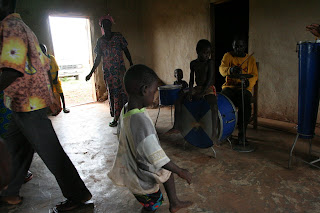 What did we expect an African church service to be like before we came to Africa? The closest thing we could picture was a lively praise followed by a preacher soliciting Hallelujah’s and Amen’s from the crowd, Southern Baptist style. But that’s like expecting a Chinese church in China to behave like a Chinese church in Canada. We’ve now visited three different churches, each with their own style, but all quite different from what we may expect in North America.
What did we expect an African church service to be like before we came to Africa? The closest thing we could picture was a lively praise followed by a preacher soliciting Hallelujah’s and Amen’s from the crowd, Southern Baptist style. But that’s like expecting a Chinese church in China to behave like a Chinese church in Canada. We’ve now visited three different churches, each with their own style, but all quite different from what we may expect in North America. The school that Dora and I teach at is supported by the ECG, or Evangelical Church of Ghana, and we consider that our home church in Ghana (second photo). A few main differences between that our home church in Vancouver:
The school that Dora and I teach at is supported by the ECG, or Evangelical Church of Ghana, and we consider that our home church in Ghana (second photo). A few main differences between that our home church in Vancouver:- We start with some singing. Music is simple, but loud. Usually just percussion (drums and a pair of bongo drums) accompaniment.
- dancing in the aisles and at the front (men and women) is common. They will form a line, dancing to the front, waving their handkerchiefs to the beat
- no such thing as silent prayer. Instead, everybody vocalizes their thoughts to God in unison, a cacophony of voices delivering their prayers towards the heavens.
- giving offering is a joyous affair, with music guiding all attendees to dance towards an offering box at the front.
- no powerpoint. Everybody knows the words to the songs by heart. The worship team communicates the order of the songs by singing the first line, then everyone else joins in.
- They like repetition. Other than 1 or 2 songs new songs, they sing the same songs every week, and everybody loves it!
- service is in two languages – English and Dabani (the local dialect here). A translator is usually used
- they welcome each other like we do in Vancouver, and most people will circulate throughout the entire church to do so (not just the neighbouring rows)
- the church building is made of simple four walls of concrete blocks and a steel roof.
- nearly 100% participation in singing and clapping. I don’t see many shy people here.
- Men and women sit separately. It’s roughly a 3:5 ratio of men to women.
- about 100 people attending
The second church we visited was in a small farming village (first photo). We drove for about 15 minutes off the main road through the bush to get there. The road was so seldom used that grass growing in the middle of the road was taller than the hood of our car. The church was a smaller building, and we had maybe 30 people in attendance. Again, percussion drove the praise, albeit on a very simple drum set. Small barefooted children danced during the music, then slept on the floor during the sermon.
The third church was a baptist church with at least 200 people near our house. Their music included a synth, bass guitar, and drums. It was also amplified uncomfortably loudly, but nobody seemed to mind. The singing lasted at least 45 minutes, and engaged everybody with clapping and dancing, a little too enthusiastic for our tastes. We were told that this church encouraged tithing or fundraising in a more direct way, by calling people up and asking others to donate a certain amount to “free” that person.





